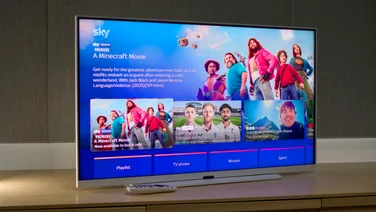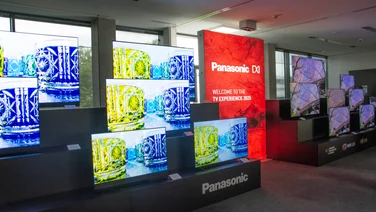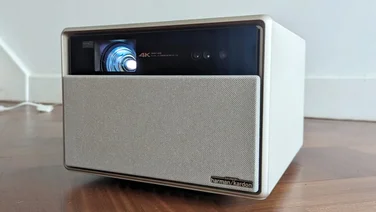To help us provide you with free impartial advice, we may earn a commission if you buy through links on our site. Learn more











Having been in Paris for the launch of TCL’s new Mini LED TV lineup in March, I had a pretty good idea of what to expect ahead of its “Experts meet Experts” event in Poland this week.
The Chinese manufacturer had already confirmed which QD-Mini LED models will be coming to the UK, provided an extensive breakdown of their specifications, and given pricing for every screen size of its new TVs.
But its latest showcase allowed me to spend hands-on time with the products, pick the brains of TCL’s product development and technical team, and test its new immersive home cinema speaker system.
There was a lot to digest, and you can expect full reviews of the standout products in the range once I’ve secured samples. For now, though, here are my biggest takeaways.
READ NEXT: TCL launches its new C-series Mini LED TVs
Large-screen Mini LED TVs will remain the brand’s focus for the foreseeable future
TCL has been championing very large TVs for several years, and super-sized options remain central to its plans.
While the brand’s Product Development Director, Marek Maciejewski, concedes that space constraints and the difficulty of installation remain limiting factors, he’s adamant that larger TVs make sense for consumers who can accommodate them.











Central to his argument is the way the human eye processes images. At a typical viewing distance of 3m, you’re getting what equates to a 1080p viewing experience on a 65in TV – but for your eyes to fully experience 4K resolution, you’d need to be looking at a screen 130in in size. TCL isn’t bringing a 130in TV to market just yet, but it’s likely only a matter of time given it already has a 115in model in its lineup.
In fact, the three core models in TCL’s UK range are all going to be available in massive sizes. The entry-level TCL C6K will be sold in 55in, 65in, 75in, 85in and 98in, the TCL C7K comes in sizes ranging from 50in to an enormous 115in, while there are 65in, 75in, 85in and 98in variants of the more expensive TCL C8K.
These models all use a Mini LED backlight. Yield issues with the manufacturing of huge OLED panels make screen sizes above 77in unviable, so Mini LED will continue to be the panel technology TCL backs for some time to come.
READ NEXT: Mini LED vs OLED
It’s a shame the UK won’t be getting the TCL X11K and TCL C9K
According to data from market research firm GfK and TCL Intelligence, sales of TVs 75in and up grew by 40% in Europe last year, while Mini LED TV sales saw 50% year-on-year growth. However, appetite for large sizes differs considerably across regions; in the Nordics, 67% of consumers have a TV of 55in or bigger, while in the UK the proportion is just 31%.











These figures go a long way towards explaining which of TCL’s new models will make it to market in the UK: there’s simply not enough demand to justify offering multiple super-sized options with similar specifications.
As a result, there are no plans to bring the TCL X11K and TCL C9K to these shores. That’s slightly disappointing, as they represent the pinnacle of what the brand is doing with large-screen TVs. The X11K, which is only available in 85in and 98in, is the brightest television in the European lineup with stated peak brightness of a retina-searing 6,500 nits, and it has the most dimming zones of any of TCL’s 2025 TVs, too.











While the C9K shares a lot of specs with the cheaper C8K, it has more brightness to draw on, a greater number of dimming zones, and a more powerful (120W vs 90W) 6.2.2-channel Bang & Olufsen audio system. As such, I expect it to be a superior TV, so the fact that we’re not getting it here is a bit of a shame.
The mid-range C7K performs admirably up against the more expensive C8K
Without the X11K and C9K, the C8K has the honour of being TCL’s Mini LED flagship in the UK this year. And, having seen it in action, I was impressed by what it delivers for the money. The 65in option costs £1,599 while the 75in (£1,999), 85in (£2,799) and 98in (£4,799) are equally aggressively priced. That’s significantly cheaper than the LG QNED93 I reviewed last month, which will cost you £1,799 for the 65in model, £2,699 for the 75in variant, and £3,799 if you go up to 85in.











However, I think the mid-range C7K is going to be the most attractive proposition in the UK lineup. It makes do without the attractive ZeroBorder (bezel-free) panel found on the step-up C8K, isn’t as bright, has fewer dimming zones and weaker B&O audio, but is a few hundred pounds cheaper across its wider range of sizes. And it’s still more than enough TV for most people; the differences between it and the C8K weren’t nearly as apparent as I expected based on their specifications.











To see how they compared, I watched a variety of streamed material side-by-side on the C7K and C8K. The additional brightness available to the C8K was evident in certain scenes; the vibrant colours of exotic animals looked punchier on it during Our Planet II on Netflix, and I was able to make out more detail in the crater of the moon during The Cloverfield Paradox. However, for the most part, the cheaper model stood up to its stablemate admirably.
READ NEXT: 7 ways to improve your TV’s picture quality
TCL’s home theatre audio solution sounds great, but the brand seems surprisingly cautious about it
In addition to showing off many massive TVs, TCL demoed its new Z100 home cinema speakers in Warsaw. These weren’t at the brand’s AV launch event in Paris, so this was the first I’d seen of them, and they were the product that made the biggest impression on me.











The Z100 are 1.1.1-channel speakers that will be sold separately and can be used individually, but they’re primarily designed to be used in a group of four to deliver surround sound wirelessly in conjunction with compatible TCL TVs.
They do so by utilising Dolby Atmos FlexConnect technology. This was debuted at IFA in 2023 and optimises Atmos output regardless of the number of speakers used and where they’re positioned. Simply place each satellite in a convenient spot (N.B. they all require mains power) and run a calibration through the TV to get set up.











With four Z100s and the speakers on TCL’s entry-level C6K engaged, you’re getting a virtualised 7.1.2-channel audio experience, and this proved highly immersive across a range of content.
The Dolby Atmos Leaf demo showcased the setup’s ability to convincingly articulate height effects and move audio cues around a believable three-dimensional soundstage. I got a strong sense of the leaf’s vertical motion as it fell, and the right-to-left movement was tracked effectively by the pair of speakers situated behind me.











The quartet of Z100 produced a large and rather terrifying soundscape during a particularly fraught scene in The Fall of the House of Usher on Netflix. Pouring rain and blood-curdling screams were smartly assigned to each of the speakers and, with volume at 70%, the experience wasn’t too different to being sat in my local cinema.
My main criticism of the setup relates to dialogue. This comes from the centre channel, which is handled by the TV’s in-built speakers, and it was swallowed up in more intense scenes when I pushed the system to its volume limits. However, given just how loud four Z100 speakers go, I can’t see many people needing to engage those levels of volume.











Despite the Z100s I heard in action being retail-ready units, the TCL team were keen to stress that they’re taking a wait-and-see approach with the product. Each speaker is set to cost between €200 and €300, so you’re looking at close to a grand for a set of four. That seems reasonable for what you’re getting, but whether there’s demand for what is a relatively pricey audio solution among TCL’s audience remains to be seen.
As such, there’s no guarantee that the Z100 will be rolled out widely, let alone hit shelves in the UK. I hope they do, as the system has a lot of potential, but it’s important to remember that you’ll also need to own a compatible TCL TV, which does limit their appeal.
READ NEXT: Best soundbars
New panel technologies for consumer TVs are still a long way off
My final takeaway was that those waiting for the next big innovation in mainstream TV panels shouldn’t hold their breath.
While TCL is busy working on various panel technologies, including ink-jet printed OLED, Quantum Dot Electroluminescent (QDEL) OLED and HFS LCD (its take on Fringe Field Switch technology), these won’t be making their way to consumer TV sets anytime soon.
All three approaches are currently only viable on smaller screens, and Marek Maciejewski said we’re looking at years before they’ll be available to the sort of big-screen TVs TCL is focused on right now.
So, for the time being at least, we can expect TCL to continue squeezing every last nit of brightness from Mini LED panels and cramming in as many dimming zones as is humanly possible to further optimise the performance, as anything else is a fair way off.






